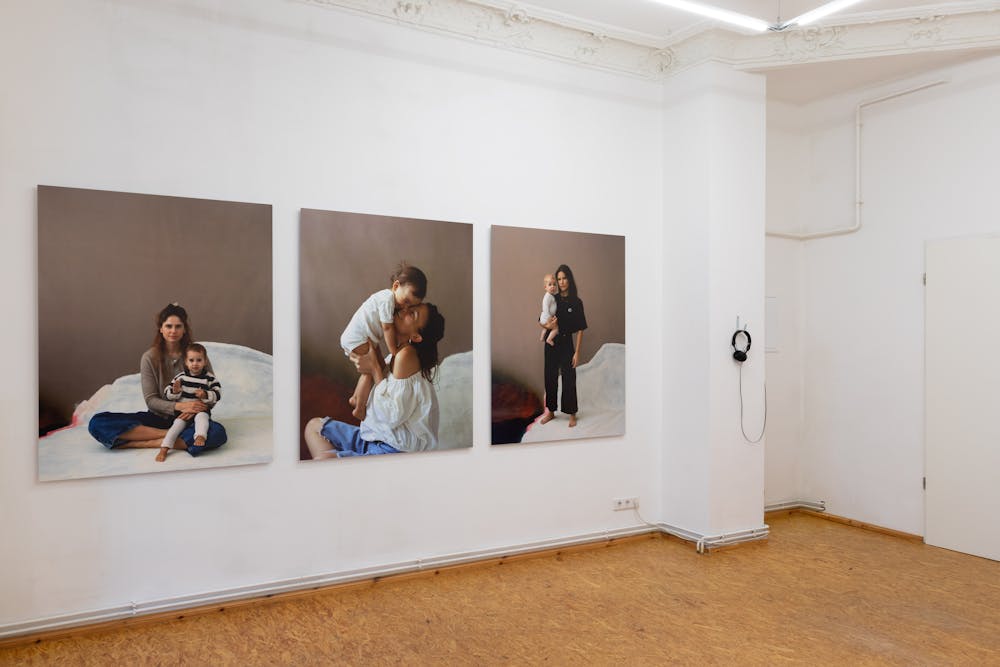Photographer Marina Hoppmann on her long running photography project.

“Mothers and Daughters” is a series of photographs that explores the grief of losing one's own mother at an early age. For the series, photographer Marina Hoppmann portrayed young women who share this fate with her. We spoke to Marina about her first exhibition with “Mothers and Daughters” her own changing relationship to grief and her work.
Kemmler Foundation: “Mothers and Daughters”, your long time photography project was shown in December last year in Berlin. What was it like, having your work out in the open like that?
Marina Hoppmann: The exhibition was a huge step for me. Until then, I had only published the images online and was somehow afraid of showing this theme in an exhibition context. I thought it would be too emotional for me personally and I wasn’t sure what the atmosphere would be like at the opening and in the exhibition space. But especially on the opening evening, the mood was very special. On the one hand it was cheerful, lots of friends came, we toasted and laughed a lot. On the other hand, there was also room for sadness. Some people who read the accompanying notes and listened to the audio recordings cried and hugged each other. Both sentiments were present at the same time, which I found really beautiful.
This simultaneity of different emotions is really important to me. Every emotion should be allowed to emerge and be expressed. During the following days, some people came who had experienced a similar blow of fate, who had gone through phases of grief in their lives. The exhibition provided a framework for sharing their experiences. I had the impression that it took a lot of effort for people to come to the exhibition, but that it is also a relief to deal with grief and talk about it.

"I felt the urge to talk to women who have suffered the same loss."
You had worked on "Mothers and Daughters“ for many years…
I lost my mother when I was seventeen and I knew I wanted to make a project about her and about this pain of loss, for quite some time. In the beginning I didn’t know how and felt too vulnerable to start the project. Yet I had this strong longing for exchange and felt the urge to talk to women who have suffered the same loss and who might have similar feelings. I have a lot of clothes from my mother, in which I feel really safe and close to her. This led me to the idea to take a portrait with her, with her on my mind and with her clothes on my body. I wanted to honor and visualize our relationship, even if she’s not around anymore.
That was the starting point and from then on I met more and more women who had lost their mothers at an early age and photographed them in their deceased mother's clothes. In the course of the project, which lasted about 3 years, 3 of the women I photographed became mothers themselves. This made me wonder how early loss effects the process of becoming a mother oneself. What influence does this new stage of life have on one's own mourning process? Does becoming a mother create a new connection to your own deceased mother?
This is how the last three pictures of the series were created, in which I portrayed the three women together with their children.

In the exhibition, the photographs were accompanied by testimonies of the women you portrayed. How do you find the audio testimonies interact with photography as a medium?
It's really important to me that other people get an idea, an insight into the grieving process. The project should be as honest and transparent as possible in order to sensitize other people to this process and the time it takes. I believe the audio recordings create more closeness and a deeper immersion into the emotional world of the subjects.
You are present in “Mothers and Daughters” both as an artist and in portraying yourself and your own story alongside those others. How do you feel the nature of your own grief has changed in the process?
My grief used to be more desperate and it often surprised and overwhelmed me. Over time, I have somehow gotten used to this form of deep sadness. But there are always new moments of grief — things you experience, changes in yourself and your life that you can not share with your mother. I think the project helped me to articulate these thoughts. And the shared experience takes some of the weight off. It feels good to actively revisit the relationship with my mother, to actively remember and to visualize this process. I believe the women I have photographed feel the same way.

You have spoken of grief as something that stays with the grieving all their life. Do you want to continue working on "Mothers and Daughters"? Are there still new directions you want to explore?
The exhibition was a millstone for me and I think now I need some distance from the project. But I do have some new ideas in my head for upcoming projects that will again revolve around themes of loss, femininity and motherhood. I am excited to see where my intuition takes me.








Kemmler Foundation supported the exhibition of "Mothers and Daughters" in Berlin in December 2023.